Self-Treating Height Vertigo (AKA Painting my Soffits)
There are times I think I may have been a bird in a past life. The light soaring sensation coursing through my body when climbing, taking off in planes, and riding up in elevators bolsters this theory as much as my knobby kneed, stork-like legs do. Airborne views of distant buildings, hills and the horizons as seen from the roof of a building, a tower, or some airborne vehicle fill me with wonder and inspire me, bolstering my theory that perhaps I was a panoramic viewfinder in another.
There is only one little glitch, a horrific scratch marring the 45 of “Up, Up and Away” by the Fifth Dimension playing on the turntable in my mind when ascending. Namely, Looking down. Without concrete spatial reference points, I become lightheaded, dizzy, and get that dry “I am about to fall and die, or at least break several important bones that I would need to get back up” taste in my mouth. While admittedly I would probably never qualify for a spot on an Olympic Rhythmic Gymnastics team on terra firma, aloft my coordination and body control hovers somewhere between cousin Geri from the Facts of Life and Grandma Walton after her stroke.
Yes, I was one of the many Americans who suffer from that classic Hitchcockian condition Vertigo. WAS, I have to stress. After making this self-diagnosis years ago, I recently went to Wikipedia to corroborate my theory. Interestingly, I discovered my symptoms didn’t fit neatly within the classic vertigan mold,
"Vertigo is often used (incorrectly) to describe a fear of heights, but it is more accurately a spinning sensation that occurs when one is not actually spinning. Although It can be triggered by looking down from a high place, or by looking straight up at a high place or tall object, but this alone does not describe vertigo."
Hmm, it seemed to involve a lot of spinning. When I am high up, I sway a bit but nothing akin to a wonderwomanlike twirl enters into the picture. My curiosity piqued, I investigated further. Reading on it seemed I most likely suffered from Acrophobia, or a fear of heights.
"Acrophobia has been attributed to conditioning or a traumatic experience involving heights. While an innate cautiousness around heights is helpful for survival, an extreme fear can interfere with the activities of everyday life, such as climbing up a flight of stairs or a ladder or even standing on a chair."
Egads!
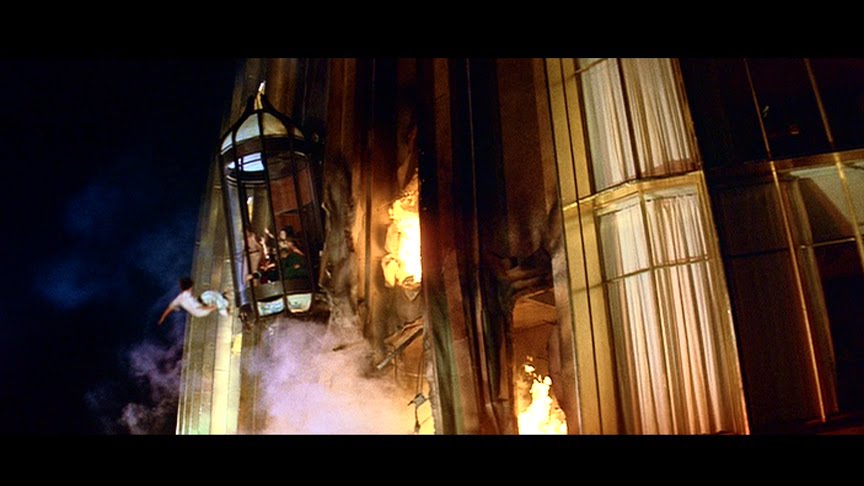
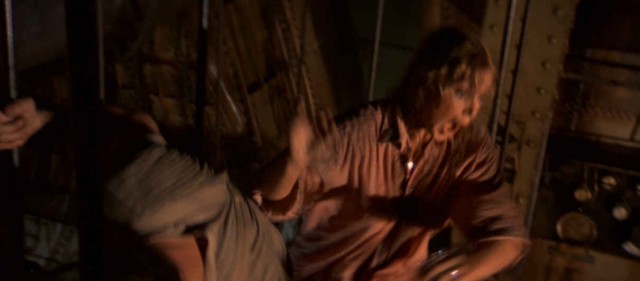
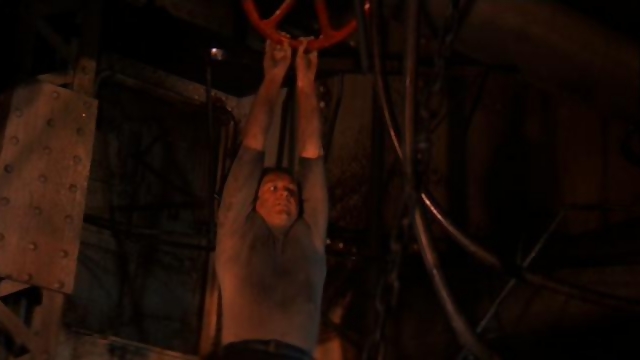
My mind went back to Irwin Allen’s Towering Inferno. Jennifer Jones, who not only managed to survive a marriage to David Selznick but also save Bobby Brady from smoke inhalation, falling from a glass elevator, plummeting through the sky in her soot streaked white chiffon, and smashed to smithereens on the pavement below. While I was at it, Stella Stevens's, Roddy McDowell's and Gene Hackman's ends in the Poseidon Adventure could have been contributing fodder to my fear of falling as well. Still, I am never one to be convinced something is entirely in my head, and I am generally fine on chairs and stairs. Luckily, It did not take long to find a physiological reason for my condition
"Vertigo is qualified as height vertigo when referring to dizziness triggered by heights.A possible contributing factor is dysfunction in maintaining balance. In this case the anxiety is both well founded and secondary. The human balance system integrates proprioceptive, vestibular and nearby visual cues to reckon position and motion. As height increases, visual cues recede and balance becomes poorer even in normal people. However, most people respond by shifting to more reliance on the proprioceptive and vestibular branches of the equilibrium system. An acrophobic, on the other hand, continues to over-rely on visual signals whether because of inadequate vestibular function or incorrect strategy. Locomotion at a high elevation requires more than normal visual processing. The visual cortex becomes overloaded resulting in confusion. Some proponents of the alternative view of acrophobia warn that it may be ill-advised to encourage acrophobics to expose themselves to height without first resolving the vestibular issues. Research is underway at several clinics."

Now it all made sense(except the part about proprioceptive branches of the equilibrium system, that's a bit beyond me). I was relieved. Vertigo and Acrophobia could be related – it was in my head AND my body, and then some! The only part I ignored was resolving the vestibular issues before exposing myself to height. The soffits on my house were in immediate need of painting, vestibular issues be damned!
The soffits are roughly 30 to 32 feet off the ground. Although the ground around the house is fairly level and there are no gables to worry about, using a ladder to paint them seemed problematic. Attempting to hold a can of paint with one hand, a brush in the other and clutch onto a ladder for dear life would necessitate a third arm. Plus some patching and repair work would have to be done before I even got to the painting. It seemed running up and down a ladder to work on a 3 feet section of soffit at a time seemed a very time consuming as well as death provoking process. Someone suggested scaffolding. One could rent it from Lowes or Home Depot and they would come set it up. That sounded like a plan, except it would have to be taken apart and set up on each side of the house, which seemed daunting and expensive.
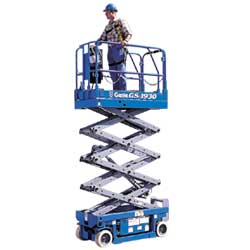
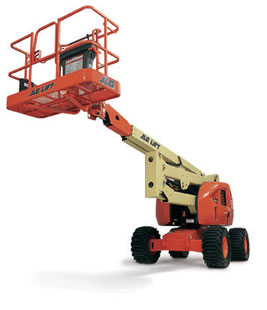
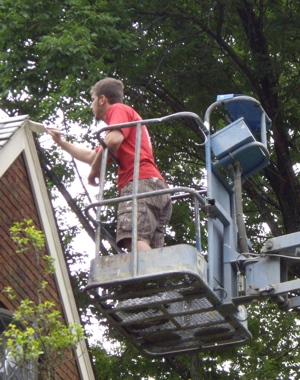
I then talked to a friend who had recently rented a lift to paint the top of his house. He explained that the lifts are self-propelled, easy to drive around the house, very maneuverable, and cost about $200 a day, (about the same price as vestibular therapy I figured). His Victorian house had a lot more detailing than mine, and he said it only took about 4 days to finish, so it sounded like a good option in terms of time and price. I asked if he felt safe when up in the bucket and he assured me it was very secure feeling (not knowing the extent of my condition). I looked at some online they certainly looked secure and easy to use I googled “Death by Lift”. I found very few examples, and those were attributed to alcohol or playing chicken. I called some local equipment rental places. There were two in the vicinity that rented lifts, and one gave me a quote of $200 day – I decided to go ahead and reserve one for 3 days. There was one little hitch. Actually, it’s that I don’t have a hitch on my jeep and the place didn’t deliver. Fortunately (at the time) I had some guys working on the schoolhouse and one had a truck. He said he could pick it up the next morning.
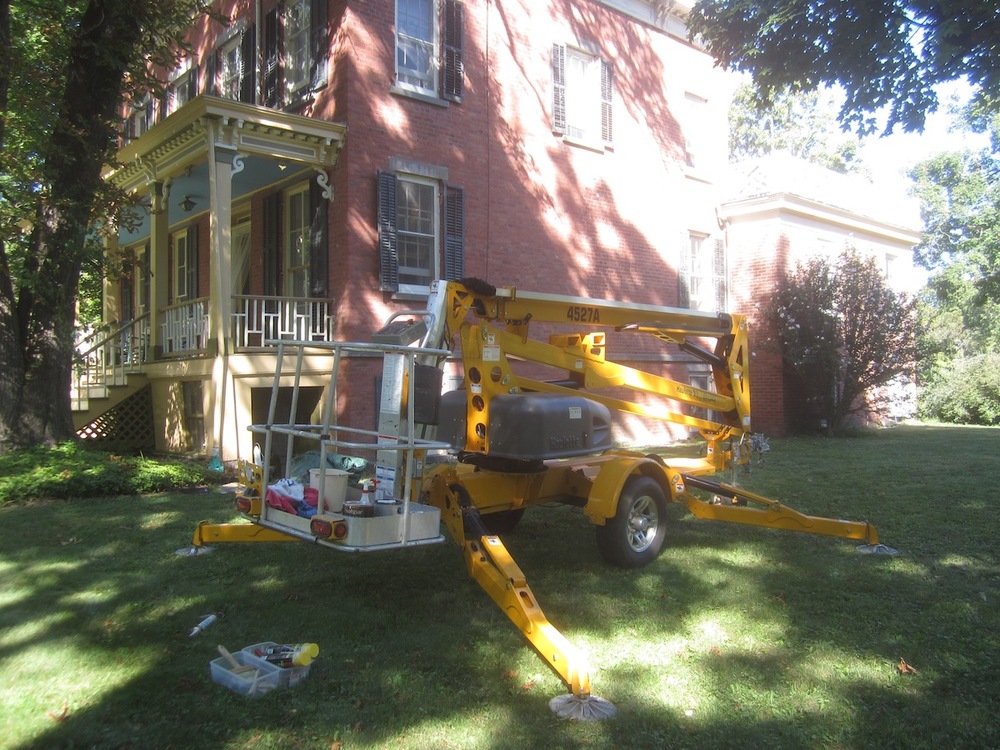
I was out early the following morning and came home full of anticipation. There it was, parked next to the house, shiny, yellow, and large - Very large. I walked around it. There didn’t appear to be any way to drive the thing. This didn’t look like the pictures I saw online. I asked Josh, who picked it up.
“How do you move this around the house?”
“You pull it”, he blithely replied.
I gave it a shove – it didn’t appear to have any ability to move easily no steering mechanism to boot. Did it not occur to the man at the rental place that if I didn’t have the ability to come pick the lift up I might not have equipment to move it around the house? “Really?” “It seems pretty heavy”
“No problem”, he assured me “We can give you a hand”.
20 minutes of four guys grunting, swearing and sweating later we had the monstrosity in a place where I could start. I read the manual carefully. Well, I read the cover carefully, which was primarily an illustration of the equipment and an admonishment to read the instructions inside carefully.


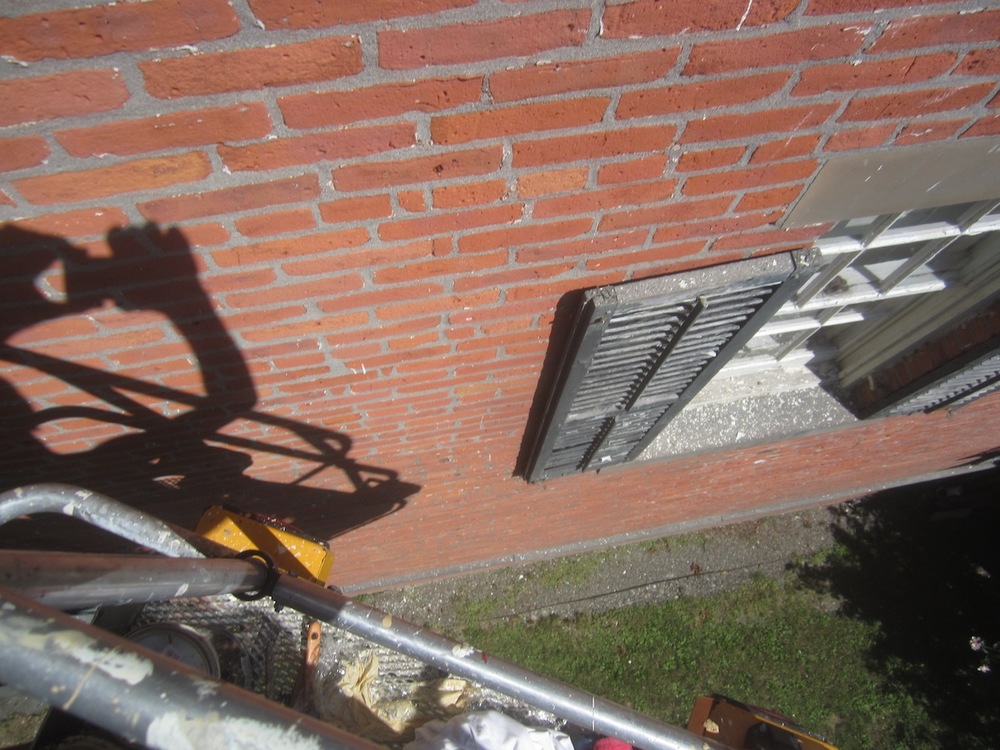
The equipment also came with a safety harness with which one could latch oneself onto the side of the platform. An added bonus! It wasn’t the easiest thing to put on, but I gamely donned it and took a practice trip up the house. For some reason I assumed operating the lift would be like operating an elevator. A smooth trip up, extend the arm to reach the tricky parts, and back down! It wasn’t that simple. Not only did you have to pivot the lift around, there were 5 different ways to extend the arms up and down, in and out. It always rose at an angle not straight up, threatening to go through a window or brain me on a tree limb while approaching the soffits. Each time I pushed a button on the control panel, the platform lurched and bobbed like a drunken sailor. When a part of the arm had extended to near the end of its reach, a horrific screeching sound would emanate from it, convincing me that it was stuck. Didn’t they oil the damn thing? I gingerly coaxed the contraption back down to earth and was about to call it a day. Remembering the falling of a bicycle adage, I put aside my fear and tried it again. The second time was easier. I gradually became more comfortable in the lift, and quickly ditched the safety harness. The part over the front porch began to come along nicely. Then I had the crew move it to the south side of the house, and I actually began to enjoy using it. I could even look down! The only problem was due to the amount repair work, and my inability to move the lift on my own, there was a 15 foot section unfinished by the time the lift had to go back after 3 days. Now that I was more comfortable up in the air I figured I could get at it with a ladder. Piece of cake. I put the ladder up against the wall, and climbed up halfway when the dry mouth, dizziness and shakiness started up again. Some vestibular therapy might be in order first.



